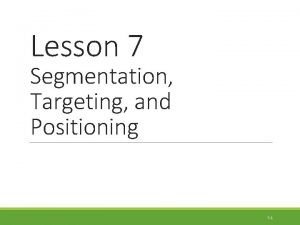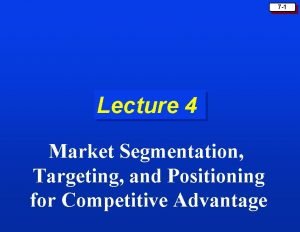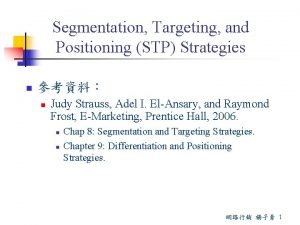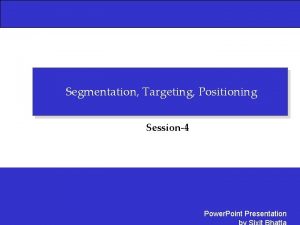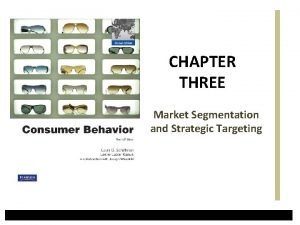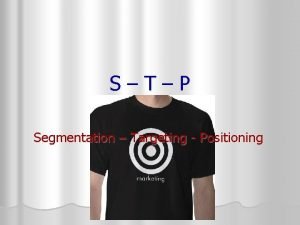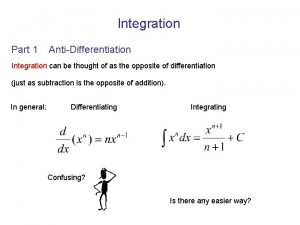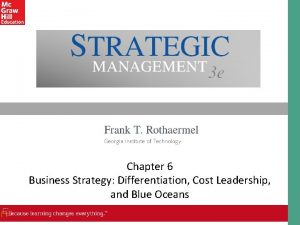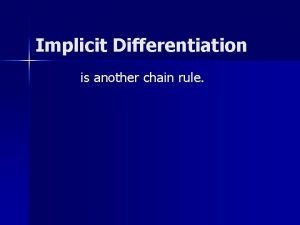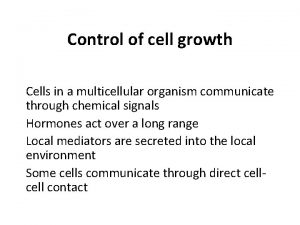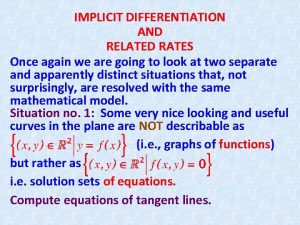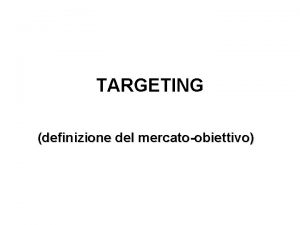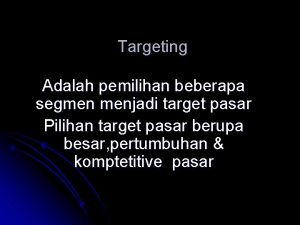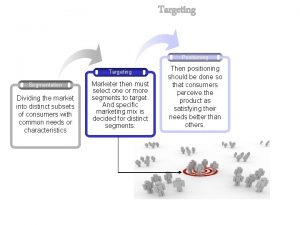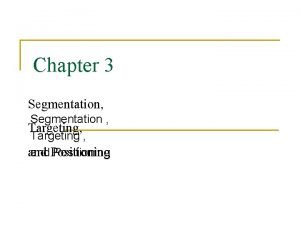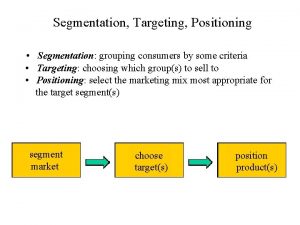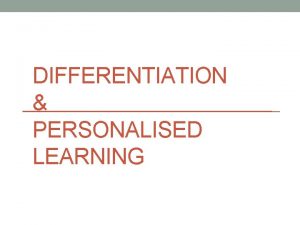Segmentation Targeting Positioning and Differentiation 7 1 Learning























































- Slides: 55

Segmentation, Targeting, Positioning and Differentiation 7 -1

Learning Objectives After studying this chapter, you should be able to: 1. Define the four steps in designing a customer-driven market strategy: market segmentation, market targeting, differentiation, and market positioning 2. List and discuss the major bases for segmenting consumer and business markets (S) 3. Explain how companies identify attractive consumer and business markets (T) 4. Discuss how companies position their products for maximum competitive advantage in the marketplace (P) 7 -2

Chapter Concepts: 1. Market Segmentation 2. Marketing Targeting 3. Differentiation 4. Positioning for Competitive Advantage 7 -3

Market Segmentation Market segmentation is the process that companies use to divide large heterogeneous markets into small markets that can be reached more efficiently and effectively with products and services that match their unique needs. (1) Use a variety of different meaningful variables (bases) for segmenting (2) Segments can be better reached with the resources of the marketer 7 -4

Market Segmentation • Segmenting 1. Consumer markets 2. Business markets 3. International markets • Requirements for effective segmentation 7 -5

Market Segmentation Segmenting Consumer Markets Marketers try different segmentation variables, alone and in combination, to find the best way to view the market structure. • Geographic segmentation • Demographic segmentation • Psychographic segmentation • Behavioral segmentation 7 -6

Market Segmentation Segmenting Consumer Markets • Geographic segmentation divides the market into different geographical units such as nations, regions, states, counties, cities, or even neighborhoods. Localizing products, advertising, promotion, and sales efforts to fit the needs of individual regions, cities, … 7 -7

Market Segmentation Segmenting Consumer Markets • Demographic segmentation divides the market into groups based on variables such as age, gender, family size, family life cycle, income, occupation, education, religion, race, generation, and nationality. (1) Consumer needs, wants, and usage rates often vary closely with demographic variables; (2) Easier to measure than other variables; 7 -8

Demographic segmentation occupation 7 -9

Market Segmentation Segmenting Consumer Markets • Age and life-cycle stage segmentation is the process of offering different products or using different marketing approaches for different age and life-cycle groups. • Gender segmentation divides the market based on sex (male or female). • Income segmentation divides the market into affluent or low-income consumers. 7 -10

Be careful to guard against stereotypes when using age and life-cycle segmentation. Age is a poor predictor of a person’s life cycle, health, work or family status, needs and buying power. What are the traditional family life-cycle stages? - Young singles Married couples with children What are the non-traditional family life-cycle stages? (Marketers are increasingly catering to…) - Unmarried couples Singles marrying later in life Childless couples Same-sex couples Single parents Extended parents (those with young children returning home) 7 -11

Age & Life Cycle Segmentation – families with young children 7 -12

Market Segmentation Segmenting Consumer Markets Psychographic segmentation divides buyers into different groups based on social class, lifestyle, or personality traits. 7 -13

Market Segmentation Segmenting Consumer Markets • Behavioral segmentation divides buyers into groups based on their knowledge, attitudes, uses, or responses to a product. • Occasion • Benefits sought • User status • Usage rate • Loyalty status 7 -14

Market Segmentation Segmenting Consumer Markets • Occasion segmentation divides buyers into groups according to occasions when they get the idea to buy, actually make purchases, or respond to a product. – help build up product usage • Benefit segmentation requires finding the major benefits people look for in the product class, the kinds of people who look for each benefit, and the major brands that deliver each benefit. 7 -15

Occasion Segmentation – consumers buy special items for occasions like birthdays 7 -16

Market Segmentation Segmenting Consumer Markets • User status divides buyers into ex-users, potential users, first-time users, and regular users of a product. • Usage rate divides buyers into light, medium, and heavy product users. • Loyalty status divides buyers into groups according to their degree of loyalty. 7 -17

Market Segmentation Segmenting Consumer Markets • Loyalty status divides buyers into groups according to their degree of loyalty. 7 -18

Market Segmentation Using Multiple Segmentation Bases • Multiple segmentation is used to identify smaller, better-defined target groups. • Geodemographic segmentation is an example of multivariable segmentation that divides groups into consumer lifestyle patterns. 7 -19

Explain which basis would be most important to marketers of Vitamins • Demographic segmentation – age and gender • Psychographic segmentation – very active or “extreme” lifestyle individuals • Behavioral segmentation – benefits sought, with some having calcium, vitamin B 12, and even nutraceutical or herbal components 7 -20

Explain which basis would be most important to marketers of Credit Cards • Demographic segmentation – income (gold and platinum cards) • Behavioral segmentation – usage rate (the higher usage rate customers are more profitable and appealing), user status (users of competing cards or banks) 7 -21

Explain which basis would be most important to marketers of Coffee • Demographic segmentation – income for premium brands • Geographical segmentation – taste and product form (instant vs. brewed) • Behavioral segmentation – occasions (out of home, eight o’clock), benefits sought (low acid) 7 -22

Market Segmentation Requirements for Effective Segmentation • To be useful, a market segment must be: • Measurable • Accessible • Substantial • Differentiable • Actionable 7 -23

Market Segmentation Requirements for Effective Segmentation • Measurable: Examples include the size, purchasing power, and profiles of the segments • Accessible: Refers to the fact that the market can be effectively reached and served • Substantial: Refers to the fact that the markets are large and profitable enough to serve 7 -24

Market Segmentation Requirements for Effective Segmentation • Differentiable: Refers to the fact that the markets are conceptually distinguishable and respond differently to marketing mix elements and programs • Actionable: Refers to the fact that effective programs can be designed for attracting and serving the segments 7 -25

Market Targeting Evaluating Market Segments • Segment size and growth • Segment structural attractiveness • Company objectives and resources 7 -26

Market Targeting Evaluating Market Segments • Segment size and growth: • Smaller versus larger segments • Growth potential 7 -27

Market Targeting Evaluating Market Segments Segment structural attractiveness: • Competition • Substitute products • Power of buyers • Power of suppliers 7 -28

Market Targeting Evaluating Market Segments Company objectives and resources: • Competitive advantage • Availability of resources • Consistent with company objectives 7 -29

Market Targeting Selecting Target Market Segments A target market consists of a set of buyers who share common needs or characteristics that the company decides to serve Four market-coverage strategy • Undifferentiated (or mass) marketing • Differentiated (or segmented) marketing • Concentrated (or niche) marketing • Micromarketing 7 -30

Market Targeting 7 -31

Market Targeting Undifferentiated marketing targets the whole market with one offer. • Mass marketing • Focuses on common needs rather than what’s different 7 -32

Market Targeting Differentiated marketing targets several different market segments and designs separate offers for each. • Goal is to achieve higher sales and stronger position • More expensive than undifferentiated marketing − Extra marketing research − Forecasting, sales analysis, promotion, planning, and channel management − Extra promotion, advertising 7 -33

Differentiated marketing – Colgate targets different market segments with different types of toothpaste. 7 -34

Market Targeting Concentrated marketing targets a small share of a large market; the marketer goes after a large share of one or a few niches. • Niche marketing • Appealing when Limited resources Greater knowledge of consumer needs in the niches Special reputation • More effective and efficient • Higher-than-normal risks 7 -35

Market Targeting Micromarketing is the practice of tailoring products and marketing programs to suit the tastes of specific individuals and locations. • Local marketing • Individual marketing 7 -36

© Stephan Mosel © Gene Lee BK Double Rendang Micromarketing – fast food chains like Burger King introduce rendang burgers in Singapore and Malaysia, where local palates prefer spicy food. 7 -37

Market Targeting Local marketing involves tailoring brands and promotion to the needs and wants of local customer groups (cities, neighborhoods and stores). • Benefits of local marketing • Increased marketing effectiveness in competitive markets • More customer-specific offerings • Challenges of local marketing • Increased manufacturing and marketing costs • Less economy of scale • Logistics • Dilution of company image 7 -38

Market Targeting Individual marketing involves tailoring products and marketing programs to the needs and preferences of individual customers. • Also known as: • One-to-one marketing • Mass customization • Markets-of-one marketing 7 -39

Market Targeting Mass customization is the process through which firms interact one-to-one with masses of customers to design products and services tailor-made to meet individual needs. • Has made relationships with customers important in the new economy • Provides a way to distinguish the company against competitors 7 -40

Mass customization by banks to reach groups of customers who hold large sums of savings and investments with the bank 7 -41

Market Targeting Choosing a Targeting Strategy Depends on: • Company resources • Product variability • Product life-cycle stage • Market variability • Competitor’s marketing strategies 7 -42

Market Targeting Which targeting strategy is best: 1. When the firm’s resources are limited 2. Uniform products such as grapefruit or steel 3. Products that vary in design such as cameras and automobiles 4. When a firm introduces a new product 5. Most buyers have the same tastes, buy the same amounts, react the same way to marketing efforts 6. When competitors use differentiated marketing 7 -43

Market Targeting Socially Responsible Target Marketing • Concerned with the issues of targeting vulnerable or disadvantaged consumers with controversial or potentially harmful products • Vulnerable segments: children, minorities • Controversial products: alcohol, cigarettes, fast-food • Benefits both company and targeted customers with specific needs • Case: Tainted Sanlu Infant Milk Powder Incident http: //www. youtube. com/watch? v=xt. Tey 7 -3 Zuk&NR=1 http: //www. youtube. com/watch? v=Ms. In 6 i. Tg. L 3 Q 7 -44

Differentiation and Positioning • Product position is the way the product is defined by consumers on important attributes— the place the product occupies in consumers’ minds relative to competing products. • Perceptions • Impressions • Feelings 7 -45

Differentiation and Positioning • Positioning maps show consumer perceptions of their brands versus competing products on important buying dimensions. • Price and orientation 7 -46

7 -47

Differentiation and Positioning Choosing a Differentiation and Positioning Strategy • Identifying a set of possible competitive advantages to build a position • Choosing the right competitive advantages • Selecting an overall positioning strategy Competitive advantage is the advantage over competitors gained by offering greater value either through lower prices or by providing more benefits that justify higher prices 7 -48

Differentiation and Positioning Choosing a Differentiation and Positioning Strategy Step 1: Identifying a set of possible competitive advantages to build a position by providing superior value from: • Product differentiation on features, performance, style or design • Service differentiation through speedy, convenient, or careful delivery • Channels - coverage, expertise, and performance • People – hiring and training better people • Image – company or brand image 7 -49

© Nakedsky. org © Rick Hall © James Cridland Singapore Airlines may charge a higher price, but provides excellent services – product and service differentiation. © juandazeng | Flickr. com 7 -50

Differentiation and Positioning Step 2: Choosing the Right Competitive Advantages • A difference is worth establishing to the extent that it satisfies the following criteria: • Important – delivers a highly valued benefit to target buyers • Distinctive – offers in a more distinctive way • Superior – superior to other ways • Communicable – visible to buyers • Preemptive – cannot easily be copied • Affordable – buyers can pay for the difference • Profitable 7 -51

Differentiation and Positioning Step 3: Selecting an Overall Strategy • Value proposition is the full mix of benefits upon which a brand is positioned. • More for more • More for the same • Same for less • Less for much less • More for less 7 -52

Figure 7. 7 Possible value propositions 7 -53

Positioning for a Competitive Advantage Developing a Positioning Statement • Positioning statement states the product’s membership in a category and then shows its point-of -difference from other members of the category. • “To (target segment and need), our (brand) is (concept) that (point of difference). ” • To busy professionals who need to stay organized, Palm is an electronic organizer that allows you to backup files on your PC more easily and reliably than competitive products 7 -54

Video Case: Procter & Gamble Discussion Questions: 1. How does P&G use positioning to differentiate the brands in a particular product category? 2. What basis of segmentation does P&G use to differentiate the products? 3. How does P&G use its variety of brands to build relationships with the right customers? 7 -55
 Segmentation targeting differentiation and positioning
Segmentation targeting differentiation and positioning Segmentation
Segmentation Nivea positioning strategy
Nivea positioning strategy Sony market segmentation, targeting and positioning
Sony market segmentation, targeting and positioning Chosen lesson 7 segment 1
Chosen lesson 7 segment 1 Nokia market segmentation targeting and positioning
Nokia market segmentation targeting and positioning Nivea market segmentation
Nivea market segmentation Global segmentation targeting and positioning
Global segmentation targeting and positioning Process of market segmentation
Process of market segmentation Bases of market segmentation
Bases of market segmentation Market segmentation, targeting and positioning
Market segmentation, targeting and positioning Psychographic segmentation
Psychographic segmentation Benefits sought segmentation
Benefits sought segmentation Market segmentation targeting and positioning of coca cola
Market segmentation targeting and positioning of coca cola Market segmentation variable
Market segmentation variable Global market segmentation
Global market segmentation International positioning strategies
International positioning strategies Segmentation vs targeting
Segmentation vs targeting 7 principles of marketing
7 principles of marketing Marketing strategy segmentation targeting positioning
Marketing strategy segmentation targeting positioning Segmenting targeting
Segmenting targeting Presciber segmentation
Presciber segmentation Rural market segmentation
Rural market segmentation Market segmentation and strategic targeting
Market segmentation and strategic targeting Strategie positioningu
Strategie positioningu Social marketing segmentation
Social marketing segmentation Segmentace targeting positioning
Segmentace targeting positioning Jurnal internasional segmenting, targeting, positioning
Jurnal internasional segmenting, targeting, positioning Cuadro comparativo e-learning y b-learning
Cuadro comparativo e-learning y b-learning Dual super-resolution learning for semantic segmentation
Dual super-resolution learning for semantic segmentation Kwonjoon lee
Kwonjoon lee Difference between udl and differentiation
Difference between udl and differentiation Porters generic strategy
Porters generic strategy Delayed differentiation and modular design
Delayed differentiation and modular design Differentiation and integration
Differentiation and integration Differentiation cost leadership
Differentiation cost leadership How jcpenney sailed into a red ocean
How jcpenney sailed into a red ocean Service design generally differs from product design
Service design generally differs from product design Implicit differentiation vs chain rule
Implicit differentiation vs chain rule Cellular adaptation of growth and differentiation
Cellular adaptation of growth and differentiation Cellular adaptation of growth and differentiation
Cellular adaptation of growth and differentiation Implicit differentiation and related rates
Implicit differentiation and related rates Designs may be frozen with too many imperfections remaining
Designs may be frozen with too many imperfections remaining Joint targeting cycle
Joint targeting cycle Undifferentiated targeting strategy
Undifferentiated targeting strategy Undifferentiated targeting strategy
Undifferentiated targeting strategy Polygon targeting
Polygon targeting Designing a customer driven marketing strategy
Designing a customer driven marketing strategy Concentrated targeting
Concentrated targeting Concentrated targeting
Concentrated targeting Alcohol commercials targeting youth
Alcohol commercials targeting youth Gdn targeting options
Gdn targeting options Target marketing
Target marketing Protein targeting pathways
Protein targeting pathways Marketing differenziato
Marketing differenziato Targeting adalah
Targeting adalah




